The Economics and Statistics Division maintains archives of previous publications for accountability purposes, but makes no updates to keep these documents current with the latest data revisions from Statistics Canada. As a result, information in older documents may not be accurate. Please exercise caution when referring to older documents. For the latest information and historical data, please contact the individual listed to the right.
<--- Return to Archive
For additional information relating to this article, please contact:
March 23, 2023EMPLOYMENT INSURANCE, JANUARY 2023 In January 2023, there were 22,240 Nova Scotians in receipt of regular employment insurance benefits (seasonally adjusted). Nova Scotia's seasonally adjusted regular employment insurance usage declined by 120 (-0.5%) from December 2022 to January 2023.
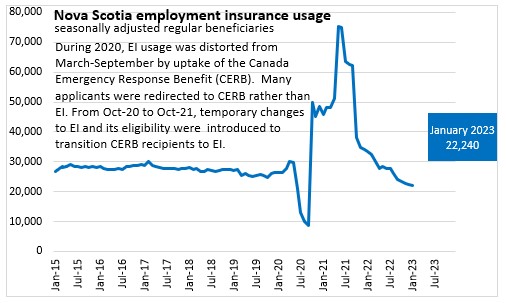
There were 374,680 Canadians that received regular employment insurance benefits in January 2023 (seasonally adjusted), a decrease of 19,830 (-5.0%) from December 2022. This was the lowest number of regular EI beneficiaries on record since comparable data became available in 1997, outside of the period when the Canadian Emergency Response Benefit was in place from March to September 2020.
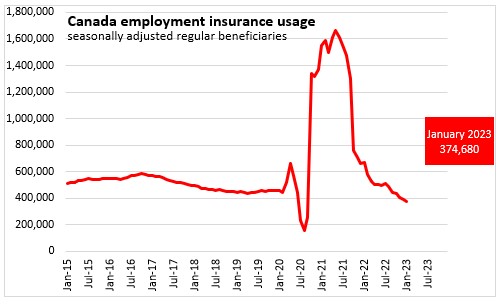
All provinces except British Columbia reported a decline in regular beneficiaries in January. The largest decline in percentage terms was reported in Quebec (-10.5%). Nova Scotia reported the lowest decline.
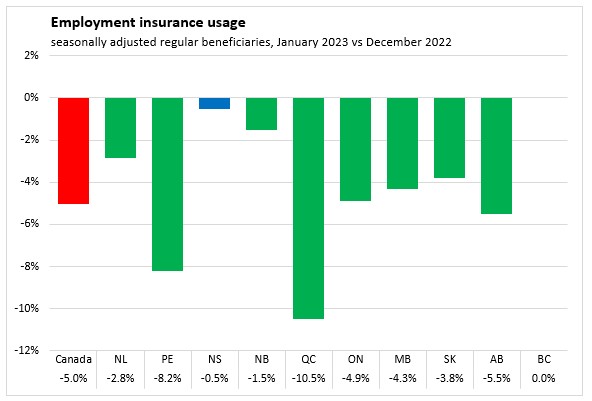
Comparing to January 2022, Nova Scotia's employment insurance usage was down by 33.6%. National employment insurance usage was down by 43.9% with declines in all provinces. The largest decline in employment insurance usage was reported in Quebec and the smallest in Prince Edward Island.

The number of employment insurance beneficiaries amounted to 4.2% of the labour force in Nova Scotia in January 2023. Nationally, the share of beneficiaries was 1.8% of the labour force.
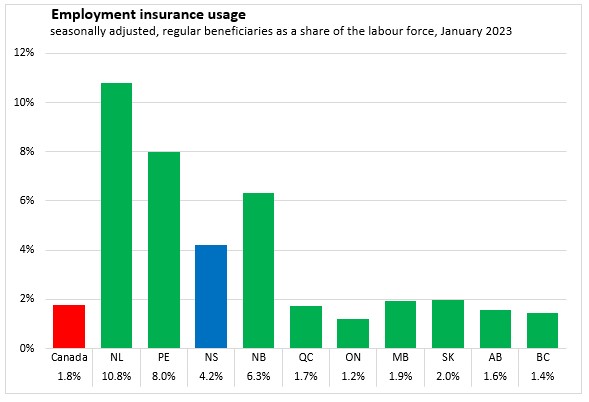
Use of employment insurance (as a share of the labour force) declined compared to pre-pandemic levels for all age cohorts of women as well as for men.
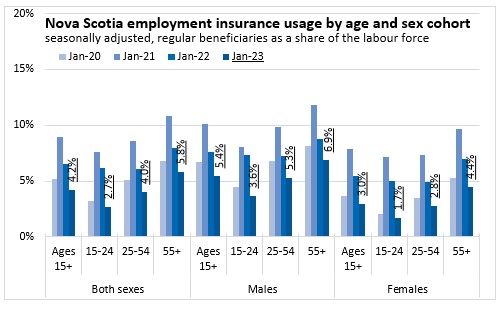
Across all age cohorts, there are fewer women than men of comparable ages using employment insurance.
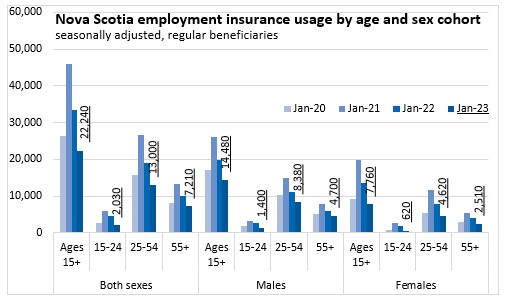
Use of employment insurance was down for all counties comparing unadjusted regular beneficiaries for January 2023 with those reported in January 2022.

In percentage terms, the largest decline in employment insurance use from January 2022 to January 2023 was reported in Halifax (-47.6%). Victoria reported the smallest decline (-13.8%).

Notes: From March to September 2020, Statistics Canada suspended publication of employment insurance statistics. Canadians were eligible for the Canada Emergency Response Benefit (CERB) during this period. Data for the period from March to September 2020 shows how an initial rise in employment insurance claims at the start of the pandemic was reversed as new employment insurance applicants were directed to CERB instead. After September 27, 2020 there was a temporary expansion of employment insurance and CERB recipients were transitioned back to employment insurance. Temporary changes, including a reduction in the number of insurable hours required for eligibility, ended in September 2021.
Source: Statistics Canada. Table 14-10-0011-01 Employment insurance beneficiaries (regular benefits) by province and territory, monthly, seasonally adjusted; Table 14-10-0323-01 Employment insurance beneficiaries by census division, monthly, unadjusted for seasonality; Table 14-10-0337-01 Employment insurance beneficiaries (regular benefits) by province, territory and occupation, monthly, seasonally adjusted; Table 14-10-0287-01 Labour force characteristics, monthly, seasonally adjusted and trend-cycle, last 5 months
<--- Return to Archive